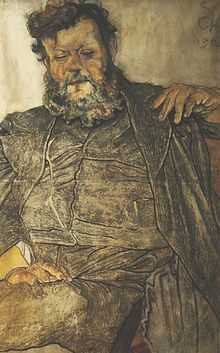Jan Stanisławski (painter)

Jan Stanisławski (June 24, 1860, Vilshana near Korsun, Ukraine – January 6, 1907, Kraków) was a Polish modernist painter, art educator, as well as founder and member of various innovative art groups and literary societies. In 1906 he became full professor of the Academy of Fine Arts in Kraków.[1]
Career
Initially, Stanisławski studied mathematics at Warsaw University (1879–1882), and subsequently at the Imperial Technical Institute in St Petersburg. He began to learn painting at the art studio in Warsaw which later gave rise to the School of Fine Arts, under Wojciech Gerson. In 1883, he enrolled in the School of Fine Arts in Kraków. In 1885, he continued his studies in Paris under Charles Emile Auguste Durand. While based in Paris, he travelled much, visiting Italy, Spain, Switzerland, Germany, Austria and eastern Galicia.[1]
His early works were exhibited at the inauguration of the Salon du Champ-de-Mars in Paris in 1890 and at the Kraków Society of Friends of Fine Arts in 1892. In the 1890s, he travelled extensively and his sketchbooks filled up with drawings from Berlin, Dresden, Prague, Kraków, and various places in Ukraine. Together with Julian Fałat, he painted the landscape parts of Napoleon’s Army Crossing the Berezina, a panorama by Wojciech Kossak.
In 1897, he initiated and helped organise the Separate Exhibition of Painting and Sculpture at Kraków’s Cloth Hall. That year, he become a teacher of landscape painting at the School of Fine Arts in Kraków, and in 1906 – after the school was upgraded to an academy in 1900 – was granted full professorship and also taught at Teodor Axentowicz’s Private School of Painting and Drawing for Women and at Teofila Certowicz’s Art School for Women in Kraków.[1]
He co-founded the Society of Polish Artists "Sztuka" ("Art") in Kraków in 1897. Later he became Deputy Chairman and finally Chairman of that society, and showed his works at numerous exhibitions organised by it. In 1898, he became a member of the Viennese Secession, and his works were exhibited among theirs in 1901, 1902 and 1905. In 1901, he became a founding member of the Polish Applied Arts Society. He worked in the Wawel Castle Reconstruction Committee and was involved in the activities of the Green Balloon (Zielony Balonik) Cabaret.[1]
After his death, two exhibitions were opened at the Palace of Art by the Kraków Society of Friends of Fine Arts in November 1907, one to show 154 of his oil paintings, as well as drawings and watercolours, and the other to present the works of his numerous outstanding students. Stanisławski was buried with honours at the Rakowicki Cemetery in Kraków.[1]
References
- ↑ 1.0 1.1 1.2 1.3 1.4 Culture.pl, Jan Stanisławski, at the Adam Mickiewicz Institute portal Culture.pl. (Polish)
- (Polish) Medium size bio, National Museum in Kraków
- (Polish) Short bio, gallery
- (Polish) Another short bio, gallery
External links
| Wikimedia Commons has media related to Jan Stanisławski. |
| Wikimedia Commons has media related to Jan Stanisławski. |
Further reading
- Krzysztofowicz-Kozakowska, Stefania, Jan Stanisławski i jego uczniowie, Kluszczyński, 2004, ISBN 83-89550-26-1
- Król, Anna, An Image of a Floating World. Japanese Art Inspirations in the Paintings of Jan Stanisławski and his Students, Manggha Centre of Japanese Art and Technology, Kraków 2007, ISBN 83-924407-5-7
|